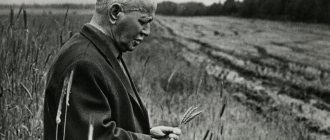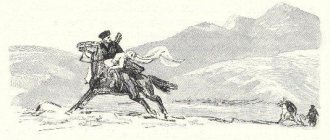Valentin Kataev
Role and place in literature
Soviet writer Valentin Petrovich Kataev lived a long, eventful life. This man was distinguished by a combination of incredible courage, decency, kindness and versatile talent. Many important historical events took place before his eyes; he is a participant in three wars - the First World War, the Civil War and the Great Patriotic War. These milestones are reflected in his work: stories and tales, plays, poems and essays. His works are used as the basis for many scripts for feature and animated films, and for the production of theatrical plays.
Origin and early years
Valentin Petrovich was born in Odessa, January 16, 1897. His father, Pyotr Vasilyevich, was a highly educated person with higher spiritual education. After seminary, he continued his studies at Novorossiysk University, after graduating from which he became a teacher at the Odessa Diocesan School. Mother, Evgenia Ivanovna, was a general’s daughter, originally from Poltava landowners. Unfortunately, she died at a young age after the birth of her second child from pneumonia.
The house where the writer was born
The Kataev family had a huge library, which consisted of hundreds of books of various directions and genres. There were classics, encyclopedias, reference books and historical books. From childhood, a love of reading was instilled in their sons; literary evenings were often held in the house, during which parents read aloud to their children.
Valentin's younger brother, Evgeny, later also became a famous writer, who, together with Ilya Ilf, wrote the immortal “The Twelve Chairs.”
Education
In 1906, Valentin entered the Odessa men's gymnasium. He wrote his first poem at the age of nine, and a year later it was published.
Valentin and Evgeniy with their father
Even before the outbreak of the First World War, young Valentin had the opportunity to meet the writer Bunin, whose work delighted the young man. He became Kataev’s first creative mentor. Later E. Bagritsky and Y. Olesha joined his circle of acquaintances.
In 1915, Kataev had to interrupt his studies at the gymnasium and his literary work because of the war. The young man volunteered to go to the front.
Creation
In 1922, Valentin left Odessa and moved to Moscow, where he got a job at the Gudok newspaper and wrote humoresques on topical topics. During this period, he signed his works with different pseudonyms: Twist, Mustard, Old Man Sabbakin, etc.
In addition to humorous songs, Kataev writes about the civil war; during this period he is the author of two published works - the novel “Time, Forward!” and the story “I am the son of the working people.”
With wife and children
After the release of the story “The Lonely Sail Whitens” in 1936, the writer’s name became known outside the USSR. In 1937, this work became the basis for the script for the film of the same name. No less popular was Kataev’s next story, “Son of the Regiment,” which he wrote in 1945. A film with the same name was made based on this work in 1946.
In the post-war period, such stories and novellas as “A Farm in the Steppe” and “Winter Evening” were published. After the release of the story “The Little Iron Door in the Wall,” the writer changed the manner of presentation and the themes of his works.
With daughter Zhenya
In a new style, which the writer himself dubbed “movism,” a number of his memoirs of the lyrical and philosophical direction “Holy Well” and “The Grass of Oblivion” were published. The novel “My Diamond Crown” caused great resonance and controversy among critics.
The state appreciated the merits of the writer Kataev and in 1974 awarded him the title of Hero of Socialist Labor and the Order of Lenin.
Major works
The main message of the story “The Lonely Sail Whitens” is that positive deeds can be done regardless of age. The main characters, the boys Petya and Gavrik, were not yet ten years old when they helped save the sailor Rodion Zhukov. The guys also delivered ammunition to the rebel workers who found themselves in a blocked area.
Monument to Kataev in Odessa
In the novel “Time, Forward!” There is no clear protagonist; engineer Margulies takes his place. The action takes place at one of the Ural construction sites. The plot of the novel is simple - work teams compete to see who can produce the most concrete, that is, increase labor productivity. This is not done for profit, but for the sake of fame and self-affirmation.
The novel skillfully captures the intense rhythm of construction, as well as the physical, creative, and intellectual contributions of the people. The novel does not call for anything and does not agitate for anything; on the contrary, the author well conveys the imperfection of socialist competition. On the one hand, management is fighting for new records, and the opposite side is presenting reasonable technical and financial counterarguments to counter this.
Monument to Petya and Gavrik
In the story “Son of the Regiment,” the plot revolves around the fate of an orphaned boy, Vanya, who is met by scouts and assigned to his regiment. There he becomes the ward of all the fighters, but Bidenko and Gorbunov show special care for Van.
So, gradually, under the guidance of his older comrades, the boy learns not only military craft, but also how to survive in extreme conditions without food and water. Vanya helps soldiers navigate the terrain during reconnaissance operations, thereby satisfying their burning desire to take revenge on the Nazis for their relatives.
Last years
At the end of his life, Valentin Petrovich collected scattered notes of his poems and copied them by hand, as a result he ended up with seven notebooks. During the writer's lifetime, not a single collection of his poems was published. According to his son, Kataev did not really strive for this. His last work, “Sukhoi Liman,” went unnoticed by both readers and critics.
In old age, the writer was diagnosed with cancer. The operation was very difficult, but after it the writer lived for another twelve years. He died of a stroke on April 12, 1986. Kataev's wife survived him by 23 years. The couple are buried in the same grave at the Novodevichy cemetery.
Chronological table (by date)
| Year(s) | Event |
| 1897 | Year of birth V.P. Kataeva |
| 1906 | Admission to the men's gymnasium |
| 1910 | Release of the first poem “Autumn” |
| 1912 | Release of the stories "Awakening" and "Dark Person" |
| 1914 | Meeting E. Bagritsky and Y. Olesha |
| 1915 | Volunteering for the front |
| 1918 | Participation in the literary circle “Green Lamp” |
| 1920 | Valentina and her brother are arrested by the Cheka |
| 1922 | Moving to Moscow, Meeting Bulgakov |
| 1923 | Start of work in satirical magazines “Crocodile” and others. |
| 1924 | Release of the novels “The Island of Erendorf” and “The Lord of Iron” |
| 1926 | Meeting M. Zoshchenko |
| 1927 | Release of the play “Squaring the Circle”. Departure for Italy |
| 1928 | Release of the book "Father" |
| 1931 | Publication of the play “A Million Torments” |
| 1932 | The release of the novel “Time, Forward!” |
| 1937 | Screen adaptation of the story “The Lonely Sail Whitens” |
| 1940 | Moving to Peredelkino |
| 1942 | Publication of the stories “Lieutenant”, “The Third Tank” |
| 1943 | Work as a war reporter on the Kalinin Front |
| 1945 | Release of the story “Son of the Regiment” |
| 1946 | Stalin Prize for "Son of the Regiment" |
| 1951 | Release of the novel “For the Power of the Soviets” |
| 1955 | Appointment as editor-in-chief of the magazine "Yunost" |
| 1963 | Trip to Paris and USA |
| 1969 | Release of the story “Cube” |
| 1973 | Publication of the story “Violet” |
| 1976 | Election as a member of the Académie Goncourt |
| 1980 | Publication of the story “Werther has already been written” |
| 1985 | Release of the story “Sleeping” |
| 1986 | Valentin Petrovich Kataev passed away |
Interesting Facts
- the writer's maternal grandfather was a general;
- Valentin’s younger brother, Evgeny, is the same Petrov who, together with I. Ilf, wrote “The Twelve Chairs”;
- until the end of his life the writer could not get rid of the Odessa dialect;
- the boy decided on his future profession as a writer at the age of 9;
- awarded the Order of Lenin three times;
- Kataev has never driven a car. The wife or driver was always behind the wheel.
- it was Valentin who suggested to his brother the plot of “The Twelve Chairs”;
- admired the work of Ivan Bunin;
- openly condemned A.I. Solzhenitsyn;
- after the war he was prone to multi-day drinking bouts;
- In addition to short stories and stories, Kataev wrote several film scripts.
Memory of the writer
On the house in Odessa where V.P. was born. Kataev, a memorial plaque was installed.
One of the Odessa lanes bears the name of the writer.
A separate exhibition at the Odessa Literary Museum is dedicated to Kataev.
The sculptural composition “Petya and Gavrik” (the heroes of the story “The Lonely Sail Whitens”) is located in the center of Odessa.
The Odessa children's library is named after V.P. Kataeva.
Not far from the Perm Puppet Theater there is the sculpture “Tsvetik-Semitsvetik”.
Links
https://www.valentinkataev.ru/ Website dedicated to Valentin Kataev
https://mir-knig.com/author/44666# Works by V.P. Kataeva. Reading online
https://www.youtube.com/watch?v=LYf9PLqeAWA Meeting with Valentin Kataev in Ostankino
https://histodessa.ru/pamyatnik-pete-i-gavriku/ Monument to Petya and Gavrik
Literature
Since 1922, a new stage has begun in Kataev’s life and work: the writer moves from Odessa to Moscow, works for the newspaper Gudok. His social circle included many talents of that time: Yuri Olesha, Isaac Babel, Ilya Ilf, Eduard Bagritsky. All of them, following Kataev, left Odessa to conquer the capital, and the successful pioneer helped them settle down.
Aspiring writer Valentin Kataev
Luck really smiled on the young writer. His talent is finally recognized in the capital. The publication of the story “The Embezzlers” (1926), in which the author in a satirical manner criticizes the social scourge of the time - the misappropriation of government money, was marked by great success. Stanislavsky himself suggested that Kataev stage a play based on the story. And soon she walked on the stage of the Moscow Art Theater. And the second play, “Squaring the Circle,” was staged on New York Broadway.
Following his older brother, Kataev Jr. came to conquer Moscow, whom Valentin Petrovich began to involve in the writing community.
“Every intelligent, literate person can write something,” he said.
It is noteworthy that, admonishing his brother, Kataev initiates the writing of an adventurous novel about diamonds hidden during the revolution. He shares the idea with Evgeny and his friend Ilya Ilf, inviting them to write a draft of the novel, which he himself would then improve and promote for publication.
Ilya Ilf and Evgeny Petrov
What came of this is already common knowledge. Ilf and Petrov (Evgeniy took a pseudonym after his father’s name) brilliantly coped with the task without mentoring. The written novel was widely quoted, and in gratitude for the idea it was published with a dedication to Valentin Kataev.
Valentin Petrovich was destined to go through three wars. During World War II, he again put on his military uniform and went to the front line. He worked as a front-line correspondent, wrote essays, articles, and took photographs. A famous work of that time was the story “Son of the Regiment” (1945): the image of the main character Vanya Solntsev personifies the tragic fate of many children during the war.
Writer Valentin Kataev
Kataev turned to the theme of children back in the pre-war years, when he wrote the story “The Lonely Sail Whitens,” in which the author immerses himself in the atmosphere of his native Odessa. In the characters Pete and Pavlik, who are involved in a cycle of adventure against the backdrop of a city destroyed by the 1905 revolution, one can discern the features of Kataev himself and his brother Zhenya.
The story “The Lonely Sail Whitens” (1936) opens the tetralogy “Waves of the Black Sea”, which later included the novels “Catacombs” (1951), “A Farm in the Steppe” (1956) and “Winter Wind” (1960-1961).
Valentin Kataev at work
If “Sail” can only be partially called autobiographical, then critics openly called the novel “My Diamond Crown” a memoir. The writer himself did not agree with this interpretation and even abandoned the genre definition of a novel.
“This is a free flight of my imagination, based on true incidents,” he said.
Kataev worked on the book in 1975-77, and the events described take the reader into the world of literary bohemia of the 20s.
Valentin Kataev
The originality of the work lies in the fact that, despite the real basis of the plot, the heroes, and these are famous writers and poets - contemporaries of the author, are veiled by pseudonyms-masks. And the novelty is that Kataev wrote for the first time in a style, genre and direction that was unusual for himself.





